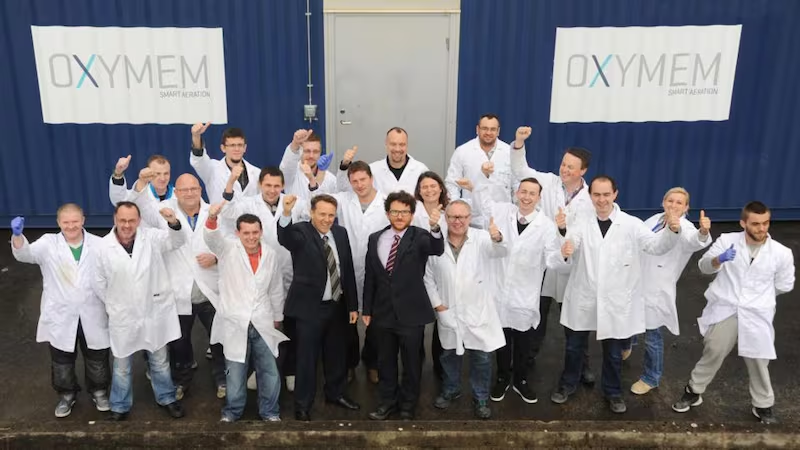While bringing improvements in the treatment of sewage and waste water might not be the most attractive of projects, great research success can still flow from it. Irish SME OxyMem turned its waste water research into a major win in the annual US-Ireland Innovation Awards.
The work saw the development of a radical new way to clean up waste water and make it safe to return to rivers and seas without risk of pollution. In the process it has reduced the high energy demand required by current treatment systems and is at least four times more energy efficient, says co-founder Wayne Byrne, chief executive of OxyMem.
Water treatment is an energy-intensive process, with countries having to commit typically two or three per cent of GDP paying for it, says Byrne. This alone might have been enough to help encourage major waste water treatment companies such as Severn Trent, Thames Water and Suez to take up the technology developed by OxyMem but this is an extremely conservative, risk-averse marketplace, says Byrne. Capital expenditure is based on 20- to 60-year plans and the systems must not fail if it puts consumers at risk.
OxyMem has managed, however, to work past this and has seen its patented technology used in 30 major water treatment projects in 14 countries, he says. The company employs 23 people and it has moved into a new location in Athlone.
The company's origins date back to 1999 and research under way in University College Dublin, where Prof Eoin Casey and Dr Eoin Syron were developing something called a membrane-aerated biofilm reactor. These are water treatment systems that rely on the activity of bacteria to break down carbon-based and nitrogen-based pollutants such as in sewage.
Silicon tubes
The researchers developed thin tubes of silicon that allowed bacterial films to grow on the outside and oxygen to flow through the tube and provide the oxygen the bugs need to tackle pollution.
“The fibres are like artificial lungs. We can provide the oxygen at a very low pressure, so when the bacteria is exposed to pollutants it already has a supply of oxygen to degrade the pollutants,” says Byrne. Research continued under Prof Casey, growing to a team of between 20 and 25, and after a series of breakthroughs they had a controllable system by 2003. UCD applied for a patent in 2007 and this was granted in 2009, says Byrne.
He first encountered the technology in 2009 related to efforts by Enterprise Ireland to see research discoveries commercialised. He teamed up with the Casey and Syron and efforts to commercialise continued as the technology developed and by 2013 they were ready to spin out a company. "It was a protracted and arduous birth. It took nearly 15 years to come forward," he says.

Their first “factory” was a shed in Athlone, set up in 2014. “Then the work really started in earnest. We had a factory, one employee, a chair and a desk.”
The conservatism of this $30billion international market was a serious brake on development until the company struck an investment deal with US chemical company Dow. "This was a really major tipping point for us," he says. Dow was involved in waste water treatment systems and had merged with Corning, the world's largest silicon maker.
Dow's international credibility opened doors for OxyMem and attracted further investment including from Saudi Aramco. It also won over a previously hesitant marketplace.
At this stage the company is positioning for growth. “We are at commercial scaling. What we have been doing over the past four years is enough to earn credibility.”
A key reason for its ready uptake by water treatment facilities is the units that hold the membrane tubes are designed to be dropped straight into position. “We can drop it into an existing treatment plant and can add 50 per cent bio capacity without any rebuild and without all the up-front money for engineering.” The system is so versatile the existing tanks don’t even have to be shut off while the OxyMem units are dropped into place.
Research continues and as a consequence energy costs for the systems continue to fall. “We always have a programme ongoing with UCD and that pays dividends,” says Byrne. For OxyMem research into waste water treatment has shown breakthroughs can be delivered from the humblest of sources.
US-Ireland Innovation Award winners
OxyMem was one of three category winners selected from among eight finalist competitors and announced on May 18th.
OxyMem won the SME category, which also included Orreco, a company applying artificial intelligence for the training of elite athletes.
The Higher Education Institute category winner was SFI Connect, a research collaboration that has developed a software platform that automatically assesses audio quality on the web. It studies an audio signal and can predict how it would sound to a human listener.
Connect’s competitor in this category was DUC Insight, a project that has used Croke Park as a test bed to study computer vision as a way to assess crowd safety in restricted spaces.
The US Multinational Companies category was won by Xilinx for its development of a chip used to control 5G cellular networks. It employs a digital signal, replacing the current analogue signal and opening the potential for a user to control how the chip works.
Other competitors in this category included Abbott for its research efforts to develop a new kind of stent; Alltech for its research work on animal nutrition and how it may be possible to reduce antibiotic use; and DePuy Synthes for a study which has brought great improvements to the production of orthopaedic implants.
All projects included significant research input by Irish researchers and in collaboration with US multinationals based here.













